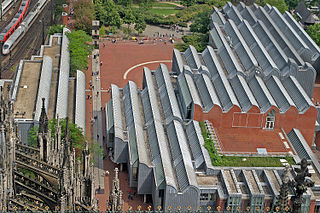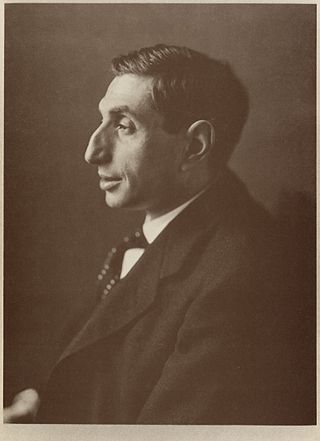Weyhe Gallery, established in 1919 in New York City, is an art gallery specializing in prints. It is now located in Mount Desert, Maine.
Erhard Weyhe (1883–1972) established the Weyhe Gallery in 1919. He also operated a bookstore, the Weyhe bookstore, at the same location at 794 Lexington Avenue. Weyhe had immigrated to the United States from England just before the start of World War I. By 1923, he had bought the brownstone building on Lexington Avenue that would house the Gallery until 1994. [1]
The Weyhe Gallery published prints singly or in portfolios. It emphasized emerging artists, and it was a prominent institution in the American art world in the first half of the 20th century. Modernist artists were among its early popular exhibitors:
Carl Zigrosser, its manager for many years, recalled that patrons like Lewis Mumford, Frank Crowninshield, Alfred Lunt and Jo Mielziner bought books and prints by the gallery's circle of artists, among them Rockwell Kent, Louis Lozowick, Aristide Maillol, Gaston Lachaise, Wanda Gág, J.J. Lankes, John Sloan, Reginald Marsh, Adolf Dehn, and Diego Rivera. [1]
In 1991, David Kiehl, associate curator of prints and photographs at the Metropolitan Museum of Art, called the building "a shrine for modern art," describing "early exhibits of the German Expressionists, of Matisse, of Picasso, of Mexican and African art". [1]
Weyhe also published an art magazine, The Checkerboard.
The gallery's first director was Carl Zigrosser, who continued in this role until 1940. Erhard Weyhe's daughter, Gertrude Dennis, operated the gallery and book store after his death in 1972 until her death in 2003. At that time, the New York City establishment closed its doors, and it was relocated to Mount Desert, Maine. Deborah Kiley, Weyhe's granddaughter, is the current owner of the Weyhe Gallery and the book store, Weyhe Art Books.
The current incarnation of the Weyhe Gallery maintains collections in the following areas: 19th century European, American Pre-1950, Classic Modernism, and American Regionalism. Among the many artists represented in its collections are John James Audubon, George Grosz, Henri Matisse, Pablo Picasso, Käthe Kollwitz, Max Weber, Raoul Dufy, Diego Rivera, Levon West, Lovis Corinth and Angelo Pinto. [2]
The files of the Weyhe Gallery from 1919 to 1994 are part of the research collections of the Smithsonian's Archives of American Art. [3]
In 2015 the Museum of Modern Art in New York restituted “Sand Hills” by Ernst Ludwig Kirchner, to the heirs of Max Fischer. MoMa had acquired the painting in 1949 from the Weyhe Gallery which had it on consignment from the estate of Nazi party member, Kurt Feldhausser. [4]
In 2018 the Solomon R. Guggenheim Foundation restituted a painting by German Expressionist Ernst Ludwig Kirchner, Artillerymen, 1915. to the heirs of the German Jewish art dealer Alfred Flechtheim. The painting had been consigned to the Wehye by the mother of Kurt Feldhausser. [5] [6]
In 2024, the New York Times revealed that a Chagall painting that the Museum of Modern Art had acquired through Weyhe from the Feldhausser estate had been quietly restituted to the heirs of the Matthiesen Gallery, and that the deaccessioning involved a payment of four million dollars to the museum. [7] [8] The painting, Over Vitbesk, had been the object of public provenance research efforts by the museum which had previously stated that the Matthiesen transfer was a repayment for debt, and not related to Nazi persecution of the Jews. [9] [10]

The Museum of Modern Art (MoMA) is an art museum located in Midtown Manhattan, New York City, on 53rd Street between Fifth and Sixth Avenues. The institution was conceived in 1929 by Abby Aldrich Rockefeller, Lillie P. Bliss, and Mary Quinn Sullivan. Initially located in the Heckscher Building on Fifth Avenue, it opened just days after the Wall Street Crash. The museum, America's first devoted exclusively to modern art, was led by A. Conger Goodyear as president and Abby Rockefeller as treasurer, with Alfred H. Barr Jr. as its first director. Under Barr's leadership, the museum's collection rapidly expanded, beginning with an inaugural exhibition of works by European modernists. Despite financial challenges, including opposition from John D. Rockefeller Jr., the museum moved to several temporary locations in its early years, and John D. Rockefeller Jr. eventually donated the land for its permanent site.

Sprengel Museum is a museum of modern art in Hanover, Lower Saxony, holding one of the most significant collections of modern art in Germany. It is located in a building situated adjacent to the Masch Lake approximately 150 metres (490 ft) south of the state museum. The museum opened in 1979, and the building, designed by Peter and Ursula Trint and Dieter Quast, was extended in 1992.

Ernst Ludwig Kirchner was a German expressionist painter and printmaker and one of the founders of the artists group Die Brücke or "The Bridge", a key group leading to the foundation of Expressionism in 20th-century art. He volunteered for army service in the First World War, but soon suffered a breakdown and was discharged. His work was branded as "degenerate" by the Nazis in 1933, and in 1937 more than 600 of his works were sold or destroyed.

Museum Ludwig, located in Cologne, Germany, houses a collection of modern art. It includes works from Pop Art, Abstract and Surrealism, and has one of the largest Picasso collections in Europe. It holds many works by Andy Warhol and Roy Lichtenstein.

The Österreichische Galerie Belvedere is a museum housed in the Belvedere palace, in Vienna, Austria.

Otto Müller was a German painter and printmaker of the Die Brücke expressionist movement.

The Hamburger Kunsthalle is the art museum of the Free and Hanseatic City of Hamburg, Germany. It is one of the largest art museums in the country. It consists of three connected buildings, dating from 1869, 1921 (Kuppelsaal) and 1997, located in the Altstadt district between the Hauptbahnhof and the two Alster lakes.

The Bavarian State Painting Collections, based in Munich, Germany, oversees artwork held by the Free State of Bavaria. It was established in 1799 as Centralgemäldegaleriedirektion. Artwork includes paintings, sculptures, photographs, video art and installation art. Pieces are on display in numerous galleries and museums throughout Bavaria.
Curt Valentin was a German-Jewish art dealer known for handling modern art, particularly sculpture, and works classified as "degenerate", seized from public museums or looted from private collectors by the Nazi regime in Germany.

Alfred Flechtheim was a German Jewish art dealer, art collector, journalist and publisher persecuted by the Nazis.
Eberhard W. Kornfeld was a Swiss auctioneer, author, art dealer, and collector based in Bern.
Max Fischer (1893–1954) was a German art collector and historian.
Fritz Nathan was a German-Swiss gallery owner and art dealer.

Many priceless artworks by the Dutch post-impressionist artist Vincent van Gogh were looted by Nazis during 1933–1945, mostly from Jewish collectors forced into exile or murdered.
The Galerie Nierendorf is a commercial art gallery based in Berlin founded by Karl and Josef Nierendorf in 1920, and reopened in 1955 as the Galerie Meta Nierendorf by Florian and Inga Karsch.

The art collection of Ismar Littmann (1878–1934), a German lawyer who lived in Breslau, comprised 347 paintings and watercolors and 5,814 drawings from artists such as Lovis Corinth, Max Pechstein, Erich Heckel, Max Liebermann, Käthe Kollwitz, Lucien Adrion, and Otto Mueller.

Curt Glaser was a German Jewish art historian, art critic and collector who was persecuted by the Nazis.

Paul Robert Ernst von Mendelssohn-Bartholdy was a German Jewish banker and art collector. The persecution of his family under the Nazis has resulted in numerous lawsuits for restitution.
Alexander Vömel, or Voemel, was a German gallery owner and Nazi party member who took over the gallery of the Jewish art dealer Alfred Flechtheim when it was Aryanized in 1933.
the work was in the possession of Flechtheim's niece, Rosi Hulisch—who committed suicide before she was to be shipped to a concentration camp—when it was acquired by Kurt Feldhäusser, a member of the Nazi party, in 1938. After Feldhäusser was killed in Germany in 1945, his art collection was left to his mother, who consigned it to the Weyhe Gallery in New York a few years later. Morton D. May of St. Louis, Missouri, purchased Artillerymen in 1952 and donated it to the Museum of Modern Art in New York in 1956. In 1988, the painting was transferred by MoMA to the Solomon R. Guggenheim Foundation in exchange for other works.
A 2017 book by researcher Lynn Rother titled Art for Credit, about the role of art used as loan collateral during World War II, states that there is no evidence that the Chagall was seized under duress, and that it was negotiated willingly by Matthiesen's gallery.